Can our canine companions and our lush green grass really get along? It may take some work, but we promise it’s more than possible. When introducing a pup to the backyard, no matter how cute he or she is, there are all sorts of ways for them to damage your prized lawn inadvertently. Will their urine cause dry spots and bare patches? Yes. Will their digging paws rip up the grass seed you diligently planted last fall? You betcha. Will their rambunctious wrestling habits with the neighborhood kids and other dogs damage the delicate ecosystem? We hate to say it, but probably.
Life with dogs is a glorious mess of fun, play, and unconditional love. And life with dogs in the backyard just means some extra attention, a few preventative methods, and maybe a new technique or two on maintaining healthy grass. But look at that adorable puppy face! You already know it’s true that, in the end, it’ll be worth it. Here are some tips to make it all a little easier.
Adjust your mower blade to a high setting
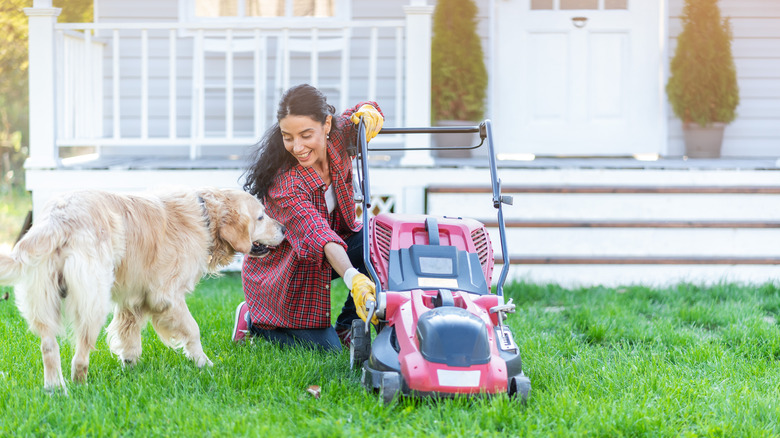
It goes without saying that a healthy lawn starts with healthy grass, but how do you keep it that way? One important piece of the puzzle relates to the length of the grass and how often you mow it. The accepted rule of thumb is to cut only a third of the blade height with each mow. This might mean waiting a little longer than you normally would, but it’s better for the grass because cutting too often can stunt growth. From there, you can figure out the ideal length you’re shooting for, which should fall around 3 to 4 inches for a cool season grass and 2 to 2½ inches for warm season grass.
In regard to sharing your yard with dogs, these lengths (or heights) are good base markers because dense, tall blades will keep urine on the surface rather than letting it permeate down toward the roots of the grass. Longer blades also provide a little shelter and a little shade for the soil below, which further optimizes the health of your lawn by locking in moisture and crowding out weeds. A healthier lawn can better handle the heavy paw traffic of boisterous canines.
Balance pH by cutting back on nitrogen
Dog urine is high in nitrogen, which you may recognize as one of the three major components in grass fertilizer (along with phosphorous and potassium). We’re usually thinking from the perspective of a nutrient deficiency and trying to add fertilizer to retain a good balance. But things get tricky when you have a dog or two regularly peeing on the grass and covering it with more nitrogen. The problem with too much nitrogen is that it affects soil pH and can lead to diseases like brown patch and Pythium.
If you’ve already spread a nitrogen-rich fertilizer, turn on the sprinklers and try to flush some of it away before it kills your grass. The next time you go to apply fertilizer, reach for compost instead. Another helpful tip is to ensure you use slow-release granules if you’re fertilizing. It’s better to let your lawn come back to life slowly than to rush it with liquid and quick-release fertilizer options that can burn the grass and exacerbate nitrogen toxicity.
Create a designated play area
marcinm111/Shutterstock
If you’ve got room to spare, the answer to an always-lush lawn may lie in separation tactics. Creating a designated play area for the pups and their friends — almost like a miniature dog park in your yard — will keep the chaos contained and let the rest of your lawn stay blemish-free. Your dog’s size, strength, and ingenuity will very much determine the size of the run and the type of fencing. While a cute puppy may not find their way over a makeshift pile of wood, a full-grown border collie will see a 6-foot high fence as a challenge it can’t wait to conquer.
Fence off a portion of the lawn and then decide whether to keep the natural grass or dig it up and use something else like a few inches of mulch or a synthetic material. Pet turf is an option very similar to artificial grass. Small rocks like pea gravel work too, and provide proper drainage. One issue with grass, if you decide to keep it, is that the enclosure will get pretty beat up and muddy. It’ll also be harder to access with the lawn mower.
Flush urine soaked grass with water
Tanya Kalian/Shutterstock
Because yellow spots from urination signify such a common and ongoing problem, you’ll want to stay on top of them with more encompassing and permanent solutions. That said, dousing the lawn with a ton of water will help in a pinch, or at least until you can erect that dog-run fence. If possible, don’t wait until you see yellow patches of dying grass. Monitor your dog to see where they go, and then move in quickly to soak the area. It will take a lot of water to saturate the lawn, neutralize the urine, and make a difference, so don’t hold back with the hose.
You’ll find commercial spot treatments that contain gypsum and baking soda promising to neutralize urine and bounce your lawn back to lush green health. However, these are not trusted tactics. Adding salt to the problem may just make it worse. At the end of the day, water is the only thing that can actually help.
Go all natural with the fertilizer
Jerome.Romme/Shutterstock
You may be thinking that a fertilized lawn and a dog are at odds with each other. It’s understandable if you want to forego synthetic commercial formulations for the safety of your pets. As humans, we have contact with the lawn on the bottoms of our bare feet, while dogs are likely to roll around in it and get absolutely covered ears to tail in whatever lurks in the grass. Dogs can be allergic to certain chemicals and, in a worst-case scenario, suffer through complications of the central nervous system, comas, and even death.
The compromise is switching to all-natural, dog-friendly, and organic fertilizers to keep your grass green. These products will be safe for pets and children, but you still want to pay attention to the application instructions on the label. They will clearly explain how much to use, when and how to apply the product, and when it will be safe to let the dogs out onto the lawn again. Of course, if you notice your pet developing a skin rash, incessantly licking or chewing on their paws, or showing any other kinds of distress, seek veterinary help and then do a thorough inventory of the products you’ve used on the grass to determine if any of them need to go.
Keep your dog cool to prevent digging
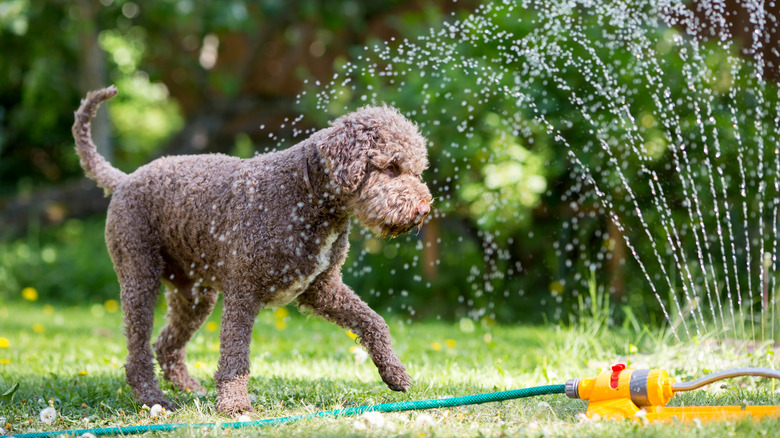
Jne Valokuvaus/Shutterstock
There are dogs who will dig no matter what just because they love it. There are dogs who will dig to bury bones and other prized possessions. And then there are dogs who will dig in search of cooler ground to rest in because, without it, they’re overheating. Digging to stay cool is more common in some breeds than others, but taking strides to keep your pet at a comfortable temperature will benefit everyone. These measures can include providing adequate shade, giving them play breaks inside in the air conditioning, or letting them frolic in a shallow kiddie pool with supervision. Turn on the sprinklers for playtime, or for little dogs, keep a spray bottle of water handy to give them a cool-down spritz.
You could also purchase a cooling vest to regulate a very active pup’s temperature. There are three different types to choose from. Some models have an ice sheet that you slide into a pocket. Some are covered in reflective material and simply reflect the sun away from the dog’s body. The most common cooling vests rely on evaporation to pull heat away from your pup’s skin. These are best suited for drier (less humid) climates.
If you have a dog that digs in the yard no matter the season or outdoor temperature, then you may have another reason to create a dedicated play area where they can do so until their heart is content.
Hydrate, hydrate, hydrate for the sake of your grass
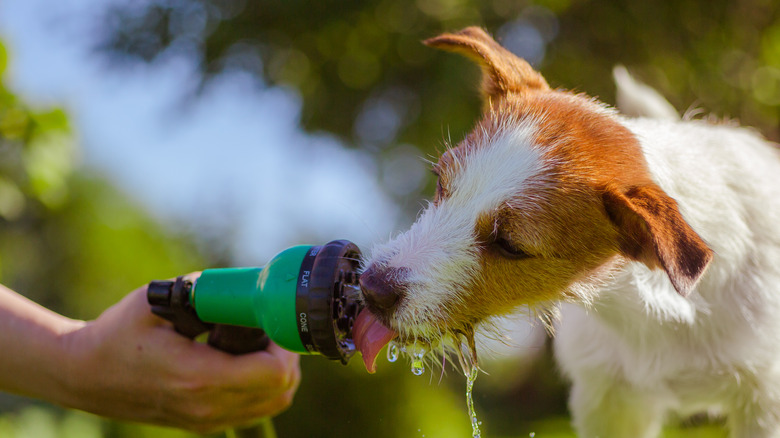
dezy/Shutterstock
Another way to keep a dog cool is to keep him hydrated. This becomes very important when you consider the devastating effects of chronic kidney disease, which can start to occur when a dog is regularly dehydrated. It may seem backward, but a dehydrated dog will develop a vicious cycle where it actually urinates more frequently and then guzzles more water to make up for the loss, only to pee it right back out. As a way to conserve water in the body, an affected dog’s kidneys will produce more concentrated urine. Over time, this concentrated urine is sure to damage your grass.
Active dogs who are outside in the yard during the heat of the day need a lot of water. Signs of over-exertion and dehydration include excessive panting, decreased appetite, lethargy, and dry gums. Make access to water easy by providing large bowls of fresh water in a few areas of the yard, letting them drink from the hose, and adding water to their food at mealtime.
Pick up the poop
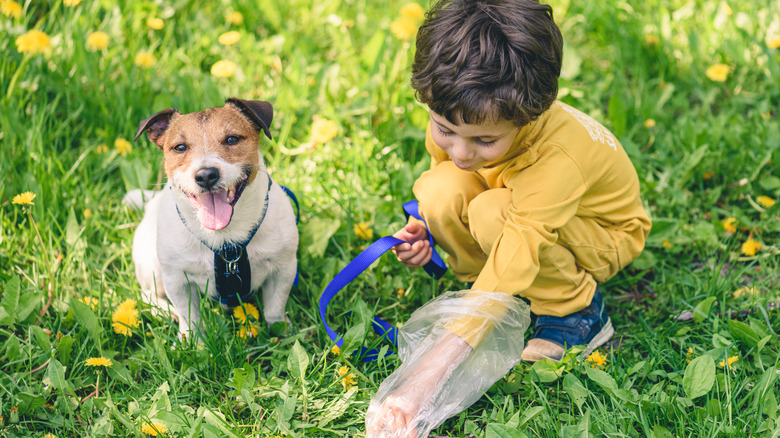
Alexei_tm/Getty Images
As a dog owner, you’ve certainly seen the signs around city parks saying dog waste is unsanitary, yet there is still this idea floating around that dog poop will act as a fertilizer for our lawns. This is a myth at best; it’s simply not true. The confusion often stems from the fact that nutrient-dense compost often contains cow manure, begging the question: What’s the difference?
The answer is in the common diet of each type of animal. Cows, horses, and sheep are vegetarians; dogs decidedly are not. Properly composted manure from farm animals that subsist on vegetables and grains actually deposits nutrients back into the soil. Dog poop, on the other hand, is laden with harmful bacteria and parasites that can make people very sick. In addition to that, a meat-based diet means that dog feces are just as high in nitrogen and do just as much damage to grass as urine. (Nitrogen is a by-product of the process that breaks down the protein in the meat.) We don’t mean to be the bearers of bad news and another chore for the to-do list, but anyway you slice it, the poop has got to go. And the quicker, the better.
Plant hardy damage-resistant grass
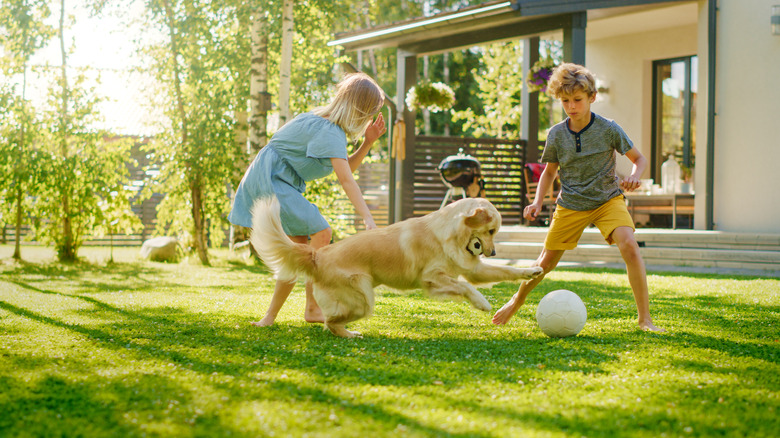
Gorodenkoff/Shutterstock
Ultimately, you want a durable lawn that can withstand puppy play, occasional defecation, and maybe a little digging from time to time. There are types of grass that have been scientifically developed just for these purposes. It might be easier if you’re starting from square one to plant an entire yard with durable grass seed, but you can begin to incorporate new seeds into your lawn even if it’s already covered in grass. In either late fall or early spring the following season, overseed damaged areas and bare spots with a new variety of tougher grass. Move playtime to a different location so the seeds can germinate and start to grow, and water regularly.
Some of the most durable types of grass are tall fescue, perennial ryegrass, Kentucky bluegrass, Bermudagrass, and zoysiagrass; your climate zone will determine which you pick for your yard. These grasses have been developed to be drought-resistant, with strong root systems and quick growth rates. Some have wide, sturdy individual blades, and others are better at creating dense turf that can stand up to the rigors of rough play. Watering schedules and general maintenance (mow height and regularity, etc.) will vary from type to type.
Train your dog to always go in the same spot
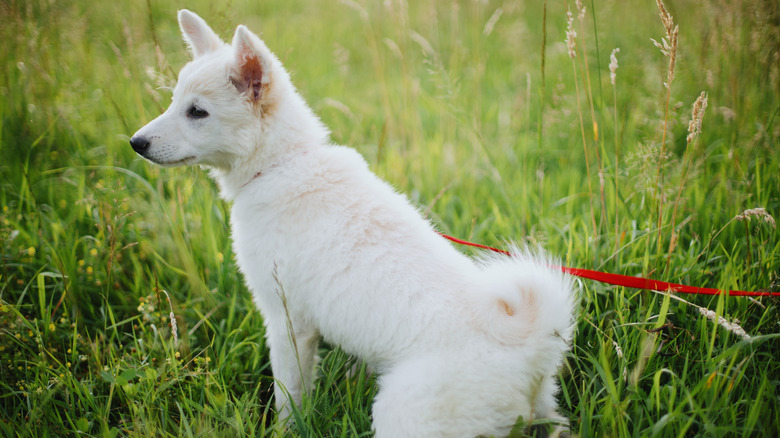
Bogdan Sonjachnyj/Shutterstock
It may be up for debate whether all dogs are trainable, but it’s undeniable that many of them are. With a lot of breeds, mutts included, you can train them to relieve themselves in the same general area, which means the bulk of your lawn will remain defecation-free. Again, this would be best for people with large yards who feel comfortable dedicating a chunk toward the back to this all-important yet icky daily ritual. The truth of the matter is you’d do best to let them pick their favorite spot and go from there, but if your pooch’s preferred pee location is right next to the grill, well, you’ll have a little more work to do.
Training your dog to always go in the same spot will take time and patience; there’s no way around that. It means no longer opening the slider and sending them out to fend for themselves. It means keeping them on a leash and directing them to the desired defecation location. And it means keeping them company until the deed is done. If you’ve tried your best and it’s just not happening, the easier solution may be taking them for a walk at a consistent time in the morning, afternoon, and evening so they take care of business elsewhere and leave your lawn free and clear.
Treat fleas naturally
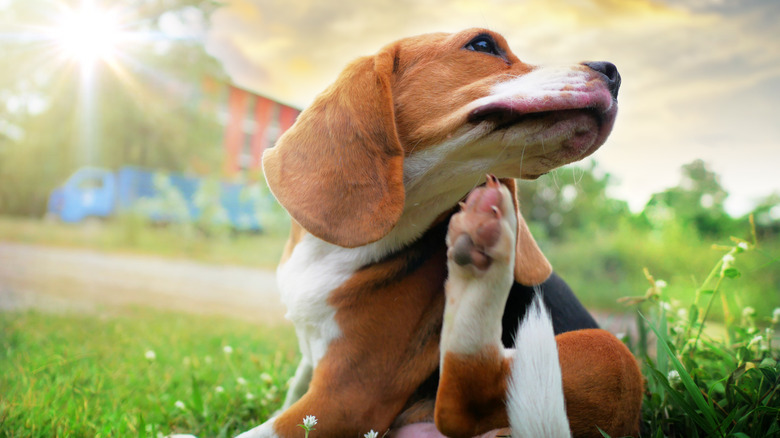
kobkik/Shutterstock
Fleas damage our pets’ skin and fur, and they can also damage our lawns by thinning out the grass and leaving bald patches. However, in addition to chemical fertilizers, chemical treatments for fleas may be something you want to stay away from for the health and well-being of your family and lawn. There are natural remedies worth giving a shot, namely diatomaceous earth and nematodes.
Diatomaceous earth looks like coarse white powder; found worldwide, it comes from fossilized algae left behind after a body of water has dried up. The definition makes it sound rare, but diatomaceous earth can be purchased at any hardware store. To use it on your grass to deter fleas, mix it with water to create a spray and evenly coat your lawn. Diatomaceous earth is not water soluble, so keep shaking the spray bottle as you go. Note that, though food-grade diatomaceous earth is deemed safe, it should never be applied directly to an animal’s skin or fur. It is meant to be used in the pet’s environment, not on the actual pet, which could cause irritations, asthma, and more.
Nematodes are available at garden centers. These microscopic roundworms will not harm your dogs, but they will wreak havoc on fleas and kill them within 48 hours. Just as with the diatomaceous earth, you’ll mix nematodes with water to create a spray solution to cover the lawn.


